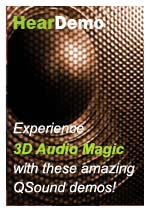Spectral Audio Technologies
The human ear is sensitive to acoustic vibrations in the range from the deepest bass at about 20 vibrations per second (Hertz) to the highest treble at over 20,000 vibrations per second (20kiloHertz). Spectral technologies affect relative power delivered across the frequency spectrum, enabling the user to customize sound playback to their tastes and equipment, or to compensate for content shortcomings.
Active Spectral Enhancement
What sets active spectral enhancement apart from so-called tone controls is its automated behaviour. QSound’s QSizzle™ (for midrange and high frequencies) and QRumble™ (for low frequencies) don’t merely boost frequencies. Rather, the user selects a desired degree of boost (and optionally, the base frequency of effect) but the processor responds to the moment-to-moment characteristics of the input and performs automatic self-adjustment. This feature enables the user to substantially enhance frequency content without introducing strident colouration, and with reduced possibility of overload during loud passages.
Active spectral enhancement is useful in a broad range of applications, but none moreso than the playback of audio files (such as .mp3) that have been digitally compressed for small download size, losing some of their sparkle and warmth as a result.
QSizzle and QRumble are sophisticated but scaleable, and are available as stand-alone algorithms, as well as features of QHD, microQ, and mQFX.
Multi-band Equalization
In place of simple bass and treble controls, this type of processor divides the frequency spectrum up into several tone bands so that the user can either boost or cut the response in each band independently.
Multi-band equalization is broadly applicable to almost any audio system thanks to its high flexibility and user familiarity with multi-band tone control. This type of spectral control is referred to as a graphic equalizer if the controls are implemented as vertical sliders, since the slider settings provide a graphic indication of the resulting filter response.
QSound’s QEQ™ is normally implemented as a 7-band processor, providing a good trade-off between sonic flexibility, interface real estate and resource use. Other configurations are readily provided upon request.
QEQ™ is implemented as a stand-alone algorithm, as well as being included by default in microQ, microQ JSR-234, and mQFX.
Loudness
Mostly misunderstood and often misused, loudness is a specific form of spectral control providing boosted frequency response at both high and low extremes of the audible range. This compensates for the ear’s reduced sensitivity to spectral extremes at low listening levels and restores equal apparent loudness across the spectrum.
Equal loudness compensation enables the user to listen at reduced volume while maintaining lively audio with warmth and presence.
Historical Note: The level-related variabilty of human frequency response was first characterized in the 1930’s at Bell Labs by two researchers named Fletcher and Munson. Equal loudness compensation is based on the “Fletcher-Munson” frequency plots they developed.

